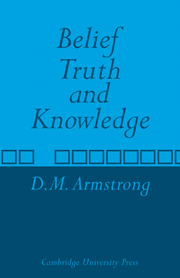8 - Further Considerations about Belief
from Part I - Belief
Published online by Cambridge University Press: 23 October 2009
Summary
Contradictory Beliefs
Before leaving the topic of belief something must be said about three topics, beginning with that of contradictory beliefs.
It will be argued in this section that it is possible to believe contradictory propositions simultaneously. The conjunction of Bap and Ba∼p is a possible state of affairs. By contrast, the conjunction of Bap and ∼ Bap is not a possible state of affairs, although perhaps there are borderline situations where saying ‘he believes it and it is not the case that he believes it’ has a point, just as saying ‘it is raining and it is not raining’ has a point when a scotch mist is in question.
There are various different cases where contradictory beliefs are held simultaneously. The first and least controversial case is that where A believes that p and believes that q, ‘q’ is in fact logically equivalent to ‘∼p’, but A is not aware of this equivalence, perhaps because it is not easy to see. Whether or not one should speak of ‘q’ and ‘ ∼p‘ as ‘the same proposition’, ‘q’ and ‘p’ are certainly contradictories.
But it is perfectly possible to hold simultaneously beliefs that are quite obviously contradictory. As the American philosopher Brian Skyrms has remarked ‘the human mind is often a disorderly thing’ (Skyrms 1967, fn. 4). It is a large place and an untidy place, and we may believe ‘p’ and ‘∼p’ simultaneously but fail to bring the two beliefs together, perhaps for emotional reasons.
Information
- Type
- Chapter
- Information
- Belief, Truth and Knowledge , pp. 104 - 110Publisher: Cambridge University PressPrint publication year: 1973
